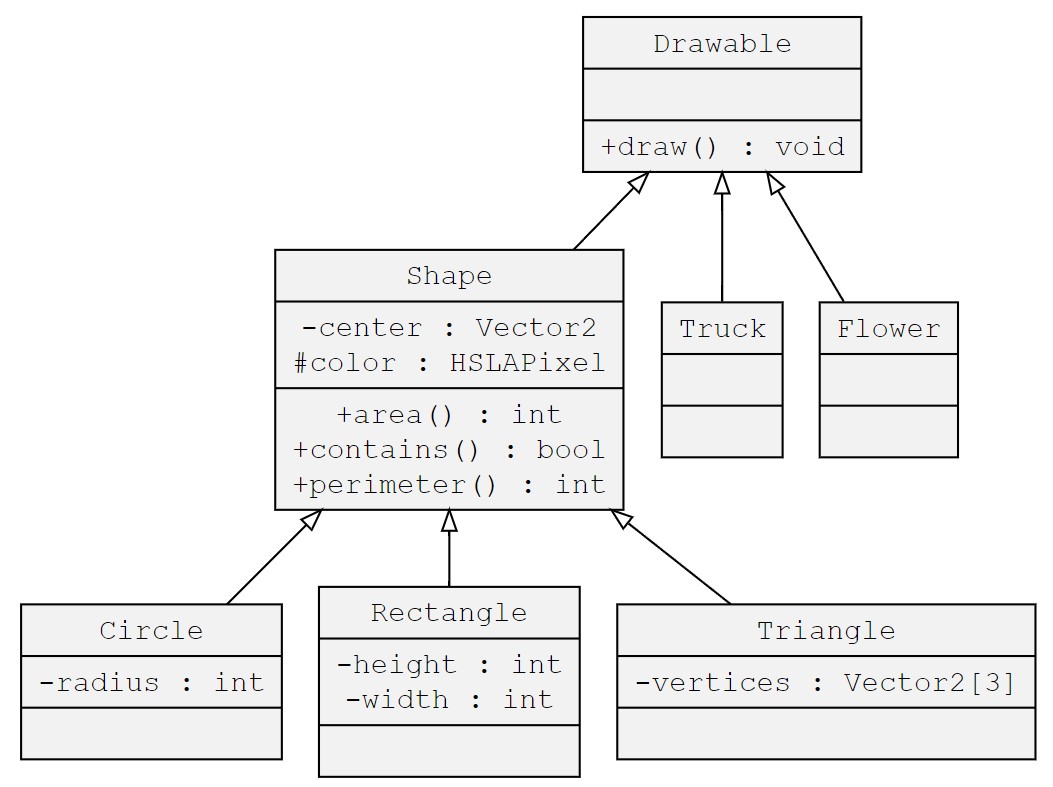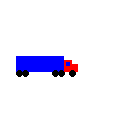LAB_INHERITANCE: Virtual Functions and Abstract Classes¶
Due date: 2024-04-08 23:59.
Lab Description¶
In this lab you will get experience with some of the implementation issues and conceptual details of inheritance. Inheritance is a mechanism for increasing the reusability and reliability of C++ code. It is worth mentioning that inheritance is a characteristic of all object oriented programming languages. Our goal is to give you a glimpse of the functionality of inheritance, so that you can make informed design decisions in the future. Please read through the entire lab before you begin. The compilation notes at the bottom will tell you how to organize your development files.
Download The Provided Files¶
Just like you already did it in previous labs, start with downloading and unzipping the provided files from here: lab_inheritance.zip.
There will be many files in your lab_inheritance directory, but you will only need to modify the following files:
- shape.{cpp,h}
- circle.{cpp,h}
- truck.{cpp,h}
- flower.{cpp,h}
- drawable.h
Background on Class Inheritance¶
To help us understand class hierarchies better here is an example of a simple class hierarchy showing that a
Dog is an Animal.
The code would look something like the following:
class Animal {
public:
string name;
virtual void speak() = 0;
/* The = 0 at the end of the method means that the method is a pure virtual method
* meaning that it does not have an implementation and it delegates the task
* of implementing the method to the classes that is derived from it */
};
class Dog : public Animal {
public:
string breed;
/* Dog inherits speak from Animal */
void speak();
};
void Dog::speak() {
cout << "Woof Woof" << endl;
}
In this example
Animals have a name and can speak but since speak is a pure virtual method we CANNOT construct an Animal by itself. That is Animal is an abstract class and it can only be constructed by one of its derived classes. For example, a Dog is a derived class of Animal. This means that a Dog is an Animal, and, therefore, it inherits a name and a speak method from Animal. However, since the Animal's speak does not have an implementation, Dog MUST implement the speak method.Here is an example of how we could use a
Dog object:Dog* d = new Dog();
/* Like usual we can access all the public methods and member variables of a
* Dog */
d->breed;
/* But now since a Dog is an Animal we can also do this too */
d->name; // inherited from Animal
d->speak(); // inherited from Animal and since it is a Dog speak() will print
// "Woof Woof"
/* Additionally we can treat our Dog only like an Animal like this */
Animal* a = d;
/* But now we can only do the following */
a->name;
a->speak(); // Still prints "Woof Woof" because speak is a virtual method.
a->breed // ERROR! This will NOT work since we perceive it as an Animal now
/* Additionally, if we try to have our Animal pointer point back to a Dog
* pointer this will cause a problem because an Animal Is NOT A Dog. */
Dog* d2 = a; // ERROR! Animal Is NOT A Dog
/* Furthermore, since Animal is abstract and has a pure virtual method
* we CANNOT construct one! */
Animal a2; // ERROR! Animal is an abstract class
Class Hierarchy¶
Now that we can understand a simple class hierarchy, let's look at a more complex one. Here is a diagram depicting the class hierarchy that is used in this lab. (Note: This diagram is missing some information, e.g. methods, member variables, etc.., for demonstration purposes)

This means everything is a
Drawable and will have a draw method. Code like the following is perfectly acceptable:Drawable* triangle = new Triangle(....);
Drawable* circle = new Circle(...);
Drawable* rectangle = new Rectangle(....);
Drawable* truck = new Truck(...);
Drawable* flower = new Flower(....);
/* Now the only thing we can use on triangle, circle, rectangle, truck, and
* flower is draw but what gets drawn will change depending on what type the
* pointer is actually pointing to. This is called polymorphism, the behavior
* changes depending on the actual type of the object being pointed to. */
PNG canvas;
triangle->draw(&canvas); // draws a Triangle even though triangle is a Drawable*
circle->draw(&canvas); // draws a Circle even though circle is a Drawable*
rectangle->draw(&canvas); // draws a Rectangle even though rectangle is a Drawable*
truck->draw(&canvas); // draws a Truck even though truck is a Drawable*
flower->draw(&canvas); // draws a Flower even though flower is a Drawable*
Fully Working Code in main.cpp¶
Look at main.cpp for a working example executable. main.cpp gets compiled and linked into an executable named lab_inheritance. Follow the instructions below to build, run, and view the output. Note that unlike most labs, this main executable is not what will be tested, but rather it is an example for you to look at to help understand how to fix the other parts.
The Makefile provided for this lab will create several useful executables when you run
make. Two of them are lab_inheritance and lab_inheritance-asan. There are other executables that correspond to the broken parts of the code, but you can also compile them separately later. So when you want to test a specific executable, you can run either the executable itself, or the -asan version of it to detect any memory errors. For example, you could run:./lab_inheritance
You could also run it as:
./lab_inheritance-asan
Additionally, you're free to run Valgrind on the normal executable:
valgrind --leak-check=full ./lab_inheritance
The output of running
./lab_inheritance is out.png. You can see that the code in main.cpp has no bugs, as the output matches the provided soln_out.png file. However, this is not the case for other executables in this lab, you will quickly see that they are not working the way they should. Your objective for this lab is to go through the five test_* executables and fix the code to work correctly by modifying how the classes in the hierarchy declare and implement their methods.A Note on the Output .png Files¶
For all of the exercises, the executable will produce a .png file that you can compare to the correct output. Look for .png files starting with soln_*, those are the correct solution outputs. Then, for each of the following exercises, compare your output .png to the correct solution soln_*.png while also making sure the console output is correct and there are no memory leaks.
Exercise 1: Fix the Virtual Methods¶
Start with building and running test_virtual:
make test_virtual # make test_virtual ./test_virtual-asan # run test_virtual with asan valgrind ./test_virtual # run test_virtual with valgrind
As you will see when you run test_virtual, the output will say:
The Perimeters are NOT the same. The Areas are NOT the same.
However, if you look closely at the code they should be the same because both of the pointers in test_virtual.cpp point to the same object!
Checklist:
- Investigate and fix the code so that the areas and the perimeters are the same.
- To fix this problem you should only need to modify shape.cpp and/or shape.h.
Exercise 2: Fix the Destructor¶
Please build and run test_destructor:
make test_destructor # make test_destructor valgrind --leak-check=full ./test_destructor # run test_destructor in valgrind make test_destructor-asan # make test_destructor-asan ./test_destructor-asan # test it with Address Sanitizer
When you run test_destructor in Valgrind or ASAN you will see that test_destructor is leaking memory. However, if you look closely,
Triangle does have a valid destructor and it is being called in test_destructor!Checklist:
- Investigate and fix the code so that there is no more memory leak inside of test_destructor.
- To fix this problem you should only need to modify drawable.h and shape.h.
Exercise 3: Fix the Constructor¶
Please build and run test_constructor:
make test_constructor # make test_constructor ./test_constructor # run test_constructor
When you run test_constructor you will see the following output:
Circle's color is NOT correct! Circle's center is NOT correct!
If you look closely, we are constructing a
Circle with a valid center and color. However, when it is being drawn and when we ask for the Circle's center and color they are not the same!Checklist:
- Investigate and fix the code so that the Circle is being constructed with the proper center and color.
- To fix this problem you should only need to modify circle.cpp.
- The correct test_constructor.png should look like the following:

Exercise 4: Fix the Pure Virtual Method¶
Please build and run test_pure_virtual.
make test_pure_virtual # make test_pure_virtual ./test_pure_virtual # run test_pure_virtual
When you try to make test_pure_virtual you will see that it does not compile.
However, if you look at the truck.{cpp,h}, it is a fully featured class! Why is it not compiling?
Checklist:
- Investigate and fix the code so that test_pure_virtual compiles, runs, and outputs a
Truck. - To fix this problem you should only need to modify truck.h and truck.cpp.
- In order to have the
Truckdraw properly you will first need to have Exercise 3 completed. - The correct test_pure_virtual.png should look like the following:

Exercise 5: Fix the Slicing¶
Please build and run test_slicing with:
make test_slicing # make test_slicing ./test_slicing # run test_slicing
After you run test_slicing open up its output test_slicing.png. You will see that a
Flower has NOT been drawn. For some reason just a bunch of X's has been drawn and a Red Circle.If you look at flower.h and flower.cpp, we have all of the proper member variables set up. However, when we try to draw them they are drawn incorrectly.
Checklist:
- Investigate and fix the code so that test_slicing outputs a
Flower. - To fix this problem you only need to modify flower.h and flower.cpp.
- You must use polymorphism!
- The correct test_slicing.png output should look like the following:

Acknowledgments¶
We would like to express our gratitude to prof. Cinda Heeren and the student staff of the UIUC CS Data Structures course for creating and sharing the programming exercise materials that have served as the basis for the labs used in this course.
Edited by: Elmeri Uotila and Anna LaValle
Anna palautetta
Kommentteja tehtävästä?